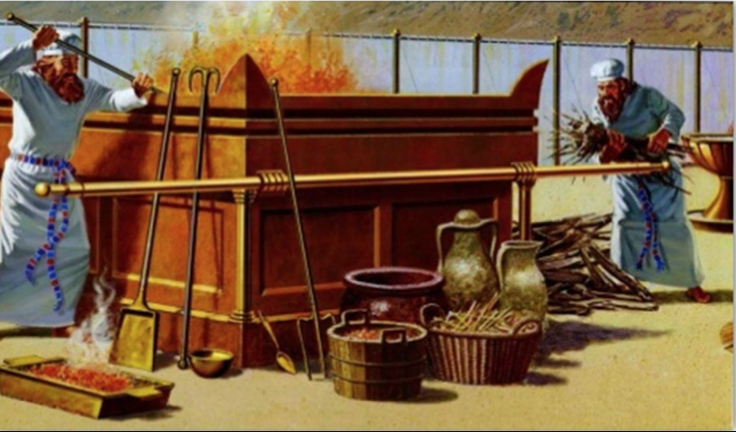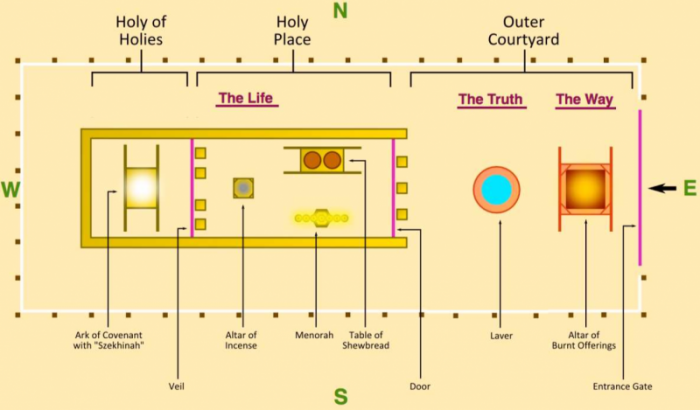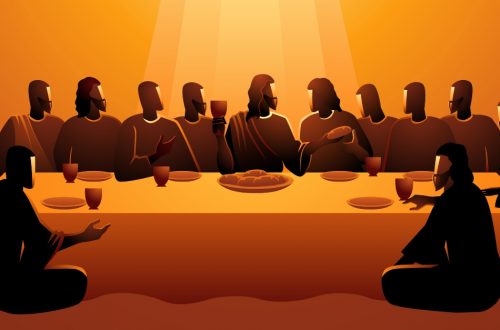
The Fire Sacrifices and Offerings of Israel – Introduction
In the composite of these five offerings, we have a gritty yet glorious presentation of Jesus Christ and His great sacrificial work on the cross of Calvary in bearing our sin and sins.
On the next day John saw Jesus coming toward him and said, “Look, the Lamb of God who takes away the sin of the world! (John 1:29 NET)
In Leviticus, the Offerings and Sacrifices are listed from the perspective of God our Father looking from the Mercy Seat outward from the Holy of Holies to a lost soul standing at the Bronze Altar in the Outer Court of the Tabernacle of Moses (1). That is, God the Father sees us through the completed sacrifices that Jesus performed for us so we can be seen by Him as perfect in Christ. However, I will list them in this article from the perspective of the lost soul entering the Tabernacle from the East to stand at the Bronze Altar in the Outer Court Tabernacle of Moses, seeking the only way to know God the Father. That is, through Jesus Christ and His sacrifice for our sin and sins.

Non-Sweet Savor to God Offerings (our sin has an awful stench!):
5. The Trespass Offering
Here sin is looked at as a trespass against the government of God. Amends had to be made for the wrong done, and the fifth part (20%) was added to it. Atonement was made by the blood of the offering, and the trespasser was forgiven. The emphasis of this offering is on the practice of sin (i.e., sins) rather than the sin itself. The Sin Offering focuses on the sin itself; however, the Trespass Offering focuses on the practice of sin, emphasizing the harmful effects of sin upon others. Therefore, this offering requires confession, compensation, and restitution for the wrong done. It was an expiation, making amends, reparation, or atonement of trespass claims of both God and man. (2) Consequently, the Book of Leviticus discussed this offering in two parts: first, sins or trespasses against God (Leviticus 5:14-19); and second, trespasses against man (Leviticus 6:1-7). This offering presents Christ who died for our sins and trespasses on the cross, restoring that He took not away (Psalms 69:4). He has not only answered to God for our sins and paid our debt by His shed blood but has added the fifth part, overpaying for our sin debt, bringing more glory to God and more blessings to man than were had before sin was committed. This is the first view the sinner gets of the Cross of Christ.
4. The Sin Offering
The Hebrew word for Sin Offering is chataat. Literally, a Sin Offering is a purification offering. It is not the only one to deal with the subject of sin, as the Trespass offering dealt with sins’ effects, but the emphasis of the Sin Offering is on the purification from sin. It emphasizes the principle of sin and atonement for the guilt of sin. Again, the Sin Offering focuses on the sin itself; however, the Trespass Offering focuses on the practice of sin (i.e., sins), emphasizing the harmful effects of sin. Also, the Sin Offering emphasizes the harm done by transgressing the Law of Moses, which brought the Curses of the Law on the transgressor (Deuteronomy 28:15-58). This offering’s special feature is in the whole bullock being burnt upon the ground outside the camp of Israel after the blood and fat were put upon the altar for God. This offering was for sin and pictures Christ, who was made sin for us (2 Corinthians 5:21) and endured the judgment and wrath of God against sin in our stead as our substitute. The holiness of God and the awfulness of sin are brought out in the bullock being entirely burnt up outside the camp.
Sweet Savor to God Offerings (the fragrance of Jesus Christ is sweet!):
3. The Peace Offering
The blood, the fat, and the kidneys of the offering were put upon the altar as “the food of the offering made by fire unto the Lord” (Leviticus 3:11). The breast was given to Aaron and his sons and the right shoulder to the offering priest. Consequently, God and man both fed on the same offering, which speaks of communion and fellowship. This typifies the communion which the believer in Christ enjoys with God on the ground of the work of Christ at the cross, and His blood poured out for our sin and sins. We are at peace with God through the work of the cross and can feed upon Christ in fellowship with the Father. (Romans 5:1)
2. The Meal or Grain Offering
This is the only bloodless offering. However, it was never offered apart from blood but was normally accompanied by blood. Before the Meal Offering was placed upon the Altar, the Burnt Offering was given first. The Meal Offering was then placed upon the Burnt Offering so that the Meal Offering always contacted blood. A portion of the Meal Offering was sacrificially offered to God in thanksgiving, and then the remainder was given to the priest for ministry. It may have been offered either cooked or uncooked. The basic content of the Meal Offering was wheat beaten into a very fine sifted flour. When Jesus was on the cross, our sins, our “leaven,” were placed on Him like a garment. Jesus was beaten, punched to become fine flour, and then placed in God’s furnace of misery, the cross, where he suffered God’s judgment in payment for all our sin and sins. In doing so, He became the Bread of Life! (John 6:51. 1 Corinthians 10:15–17 NET) This offering typifies Christ as the perfect and sinless Man and presents to us His wonderful Person and His spotless life, which was ever an offering of a sweet savor unto God.
1. The Burnt Offering
The Burnt Offering speaks of the highest aspect of the work of Jesus the Messiah, where He willingly offered Himself to God as a consecration offering unto death, dying in our place. Jesus performed this while satisfying the Levitical requirements for the burnt offering sacrifice. The whole offering, except the animal’s skin, was burnt upon the altar and all went up to God as a sweet savor. It pictures Christ who “gave Himself for us, a sacrificial and fragrant offering to God” (Ephesians 5:2). Christ is not seen here as bearing our sins but as accomplishing the Father’s will, glorifying Him, and vindicating His throne’s holiness and majesty.
Therefore, be imitators of God as dearly loved children and live in love, just as Christ also loved us and gave himself for us, a sacrificial and fragrant offering to God. (Ephesians 5:1–2 NET)
Conclusion:
Exploring the offerings and sacrifices of God provides a wonderful picture of God’s plan of redemption and of our Lord and Savior Yeshua (Jesus)! I pray that through this study, you will see Jesus the Messiah and His work of bringing salvation to fallen humanity artfully portrayed through the sacrifices and offerings of the Old Covenant. However, we are not to add observing the sacrifices, or anything else, as a requirement for salvation.
But only the high priest enters once a year into the inner tent, and not without blood that he offers for himself and for the sins of the people committed in ignorance. The Holy Spirit is making clear that the way into the holy place had not yet appeared as long as the old tabernacle was standing. This was a symbol for the time then present, when gifts and sacrifices were offered that could not perfect the conscience of the worshiper. They served only for matters of food and drink and various washings; they are external regulations imposed until the new order came. (Hebrews 9:7–10 NET)
Under the Old Covenant, the heart attitude was more important than the mechanics of all the sacrifices (1 Samuel 15:22; 2 Chronicles 30:19). (3) This continues to be true under the New Covenant. If you do not know Jesus as Lord in your heart, then please click here.
Please select the links below to continue this study:
Sacrifices and Offerings of the Old Covenant Series:
- The Fire Sacrifices and Offerings of Israel – Introduction
- The Fire Sacrifices and Offerings of Israel – The “Whole” Burnt Offering
- The Fire Sacrifices and Offerings of Israel – The Meal Offering
- The Fire Sacrifices and Offerings of Israel – The Peace Offering
- The Fire Sacrifices and Offerings of Israel – The Sin Offering
- The Fire Sacrifices and Offerings of Israel – The Trespass Offering
- The Fire Sacrifices and Offerings of Israel – The Red Heifer Offering
- The Fire Sacrifices and Offerings of Israel – The Ordination Offering
Shalom
(Security, Wholeness, Success)
Peace
Then he said to them, “Therefore every expert in the law who has been trained for the kingdom of heaven is like the owner of a house who brings out of his treasure what is new and old.” (Matthew 13:52 NET)
(1) Select the link to open another article with additional information in a new tab.
(2) Lyon, R. W., & Toon, P. (1988). Atonement. In Baker encyclopedia of the Bible (Vol. 1, p. 232, 746). Grand Rapids, MI: Baker Book House.
From atonement for sin in the OT came such terms as expiation and forgiveness. From the idea of atonement for the wrath or judgment of God came propitiation and reconciliation. Hence in modern English translations, various terms attempt to express the concept of atonement provided by God… In the Bible, both expiation and propitiation are part of God’s atoning work. Christ’s sacrifice both propitiates (turns away) God’s wrath and expiates… [removes] human sin. God’s redemptive work is both personal or relational and objective. When a biblical context concentrates on God’s wrath, propitiation is involved; when human sin is the focus, then redemption provides expiation… That expiation means “removal of sin” underscores a fundamental dimension of redemption: “as far as the east is from the west, so far does he remove our transgressions from us” (Psalms 103:12).
(3) Harris, R. L. (1990). Leviticus. In F. E. Gaebelein (Ed.), The Expositor’s Bible Commentary: Genesis, Exodus, Leviticus, Numbers (Vol. 2, p. 567). Grand Rapids, MI: Zondervan Publishing House.




One Comment
Pingback: